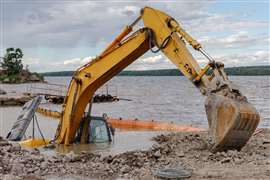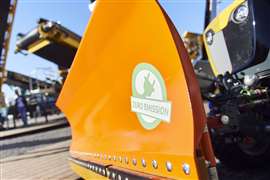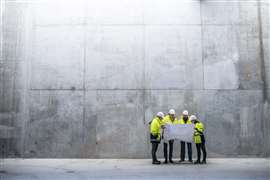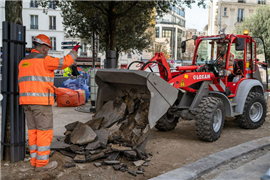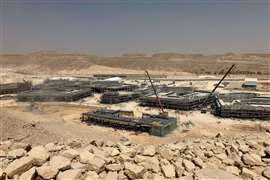Snow problem: how contractors can prepare for winter in Northern Hemisphere
18 December 2024
Winter is officially just days away in the Northern Hemisphere, and the most northerly portion can expect another season of lowered temperatures and a mix of oscillating extreme dry and moist air for the coming months. So, what can contractors and builders do to prepare?
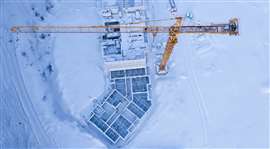 A tower crane surrounded by winter terrain. (Image: Adobe Stock)
A tower crane surrounded by winter terrain. (Image: Adobe Stock)
In the US, the National Oceanic and Atmospheric Administration (NOAA) is anticipating above-average snowfall around the northern and Great Lakes regions of the country.
The European Centre for Medium-Range Weather Forecasts (ECMWF) remains a mixed bag, with some models sensing higher than average temperatures across the continent, but particularly in Scandinavia. The ECMWF expects more moisture than average for northern countries.
The presence of a seasonal high-pressure La Niña system is driving some of the irregularities for both continental regions, and the advice on both ends is to prepare for everything this winter.
“Brace yourself,” says Merchants Fleet, a global and US-based vehicle fleet management firm, which offers products and solutions for construction machinery. “Preparing your fleet for winter is more than a routine check. It’s essential for keeping vehicles safe, efficient and ready for any weather.”
Don’t skip the basics in prepping construction fleet for winter weather
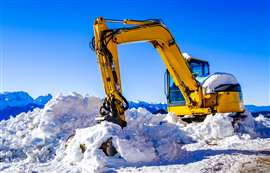 An excavator works a snowy work site. (Image: Adobe Stock)
An excavator works a snowy work site. (Image: Adobe Stock)
Merchants Fleet emphasises that winterising your fleet can make all the difference; from improving fuel efficiency to reducing unexpected downtime.
“To get your fleet winter-ready, start by checking that the coolant in each vehicle is topped off and has the appropriate freeze protection level, [and] replace the coolant if it’s insufficient or contaminated.
“Next, test vehicle batteries to ensure they’re equipped to handle cold weather starts and replace any that show signs of weakness to avoid breakdowns. Inspect air and fuel filters to confirm they’re clean and functioning optimally and replace any that are clogged or near the end of their service life.”
Other handy advice for fleet managers and contractors from Merchant Fleets includes creating a “storm profile” for machines (which anticipates increased fuel needs during extreme weather), staying ahead of braking maintenance and restocking cabs with first aid supplies.
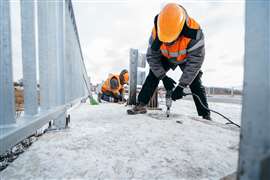 Workers use personal tools on a wintry construction site. Cold weather can increase risk of hand-arm vibration syndrome. (Image: Adobe Stock)
Workers use personal tools on a wintry construction site. Cold weather can increase risk of hand-arm vibration syndrome. (Image: Adobe Stock)
That last tip is confirmed by UK-based Glanville Training Academy (GTA), which provides health and safety awareness courses for the construction industry. GTA notes illness is up in winter, as are unique physical ailments that manifest more in cold temperatures.
“Cold stress is one potential hazard to the health of working in the winter and when the temperature falls near or below freezing, this can be severely dangerous to a person’s health with a risk of painful joints, fatigue, trench foot, frostbite, and hypothermia occurring if operatives aren’t protected from the elements of outside working,” says GTA. “In addition to an increased chance of illness as a result of the wet and cold temperatures, workers that use power tools such as concrete breaker plates and angle grinders increase their risk of HAVs (hand-arm vibration syndrome) during the colder months.
“It’s important that all workers using power tools are adequately trained on how to use their tools and a procedure is put in place to ensure their exposure is monitored and minimised.”
Construction crews must have a plan for workers, equipment during weather events
US-based Victor Insurance notes several key processes supervisors and managers can employ to reduce risk on winter construction sites.
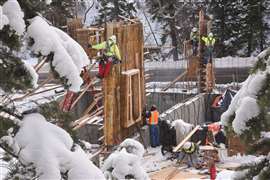 Crews work at height in winter conditions. (Image: Adobe Stock)
Crews work at height in winter conditions. (Image: Adobe Stock)
The most important step may be the easiest: plan ahead.
“Regularly check for weather updates,” Victor suggests, “[and] complete a winter weather risk assessment to help determine the correct plan of action when winter weather approaches. This should include worker training and protection, material/equipment storage and protection, and clearing roads/walkways.”
And don’t push it, adds Victor.
“Prepare for unexpected days off due to icy conditions, high winds or bad visibility. Consider alternative arrangements in advance such as weekend work that will help make up for lost time,” says the insurance firm.
Other tips include finding heated storage for equipment and machines, bringing mobile heaters onsite, heating and insulating needed water piping and educating the workforce on safely working in colder conditions.
Victor adds, “Consider breaking up individual workloads to limit worker exposure and physical exertion, provide workers with a heated break area where hot drinks are accessible, ensure workers are wearing protective clothing to help them stay warm… [and]remove snow and ice from the jobsite everyday and consider applying grit to walkways to reduce the risk of slips, trips and falls.”
US-based Kilgore Companies, a construction materials provider, notes that reduced daylight can also prove problematic to efficiency, and adjustments to the workday could be prudent.
“With shorter daylight hours in fall, we may need to adjust our work hours to make the most of the available daylight. This might involve starting work earlier in the morning or extending shifts to cover more hours of daylight,” says Kilgore.
Construction materials may be fussy
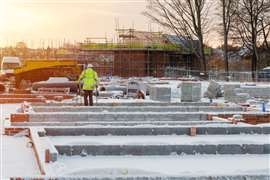 A worker navigates a construction site covered in snow. (Image: Adobe Stock)
A worker navigates a construction site covered in snow. (Image: Adobe Stock)
Kilgore adds that expectations for how construction materials behave must be adjusted, as well.
“We should also consider any changes to our construction methods or materials that might be required due to the seasonal conditions. For example, certain materials may perform differently in cooler temperatures, so we may need to make adjustments to our construction techniques or materials,” the company says.
Victor Insurance notes some instances where this becomes a regular part of the day through the winter months.
“Concrete and masonry related work can take much longer and even fail if proper precautions are not taken,” the company says. “In order for concrete to reach necessary strength levels, it cannot be allowed to freeze during the first 24 hours after being poured or placed.
“Mortar mix must be kept from freezing and at warm enough temperatures during the initial phases of installation to perform properly.”
STAY CONNECTED



Receive the information you need when you need it through our world-leading magazines, newsletters and daily briefings.
CONNECT WITH THE TEAM










